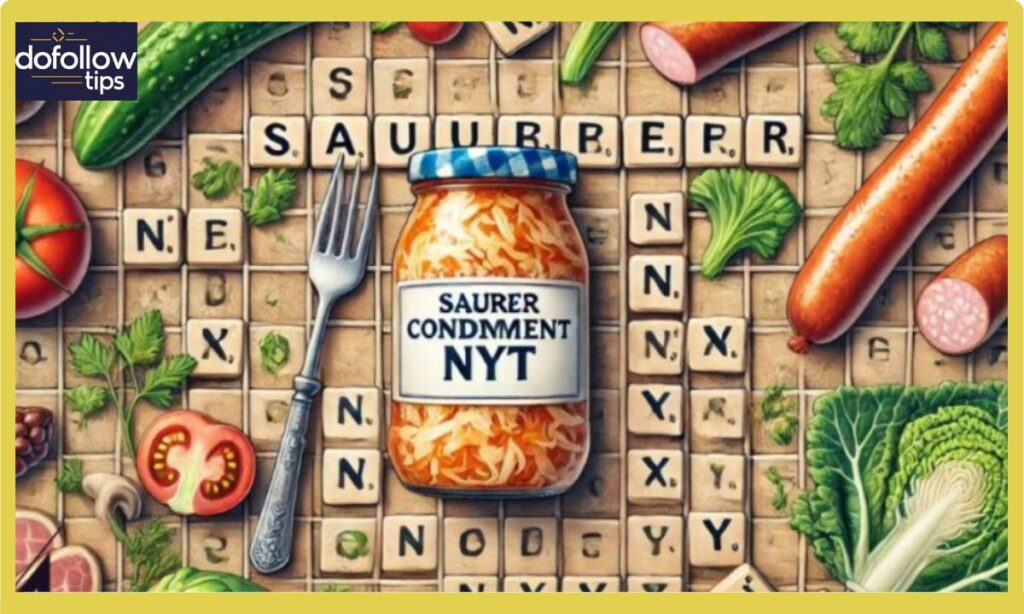Crossword puzzles challenge our minds. They test our knowledge. The New York Times crossword is renowned. It’s known for its clever clues.
One such clue is the “Sauer condiment” clue. This guide will explore this clue in depth. We’ll uncover its meaning. We’ll discuss its answer. We’ll delve into the world of sauerkraut.
What is the “Sauer” Condiment NYT Clue?
Crossword clues are often tricky. They require lateral thinking. The “Sauer condiment” clue is no exception. It appears in the New York Times crossword.
This clue has puzzled many solvers. It’s a clever play on words. The clue combines language and cuisine. It’s a perfect example of crossword creativity.
Understanding the Clue: “sauer condiment nyt”
Let’s break down the clue. “Sauer” is a German word. It means “sour” in English. “Condiment” refers to a food enhancer. It’s used to add flavor to dishes. “NYT” stands for New York Times.
This abbreviation is common in crossword circles. Together, these elements form a challenging clue. They point to a specific sour condiment. This condiment has German origins.
Answer to the “sauer condiment nyt” Crossword Clue
The answer is sauerkraut. Sauerkraut fits the clue perfectly. It’s a sour condiment. It has German roots. Sauerkraut is fermented cabbage.
It has a distinct tangy flavor. This answer satisfies all aspects of the clue. It’s a clever solution to a tricky puzzle.
Why Sauerkraut?

Sauerkraut is an ideal answer. It’s deeply rooted in German cuisine. The word “sauerkraut” itself is German. It literally means “sour cabbage”.
Sauerkraut is indeed sour. It’s used as a condiment. These characteristics make it a perfect fit. It matches the clue’s requirements precisely.
The Significance of Sauerkraut in Cuisine
Sauerkraut is more than a crossword answer. It’s a culinary staple. Sauerkraut has a rich history. It plays a significant role in many cuisines. Let’s explore its importance. We’ll look at its background, benefits, and uses.
READ THIS BLOG: Introduction to about somethingnewnow.net blog
Historical Background
Sauerkraut has ancient origins. It was first made in China. The Great Wall builders ate it. Europeans adopted sauerkraut later. German and Eastern European cuisines embraced it.
Sailors relied on sauerkraut during long voyages. It prevented scurvy. Sauerkraut’s preservation qualities were valuable. It became a dietary staple in many regions.
Nutritional Benefits
Sauerkraut is nutritious. It’s low in calories. Sauerkraut is high in fiber. It contains vitamins C and K. Sauerkraut is rich in B vitamins. It’s a good source of iron. Sauerkraut contains beneficial probiotics.
These support gut health. The fermentation process enhances its nutrients. Sauerkraut boosts the immune system. It aids digestion. Many consider sauerkraut a superfood.
Culinary Uses
Sauerkraut is versatile. It’s used in many dishes. Sauerkraut pairs well with meats. It’s common in sandwiches. Sauerkraut adds flavor to soups. It’s a popular hot dog topping.
Many salads incorporate sauerkraut. It’s a key ingredient in Reuben sandwiches. Sauerkraut complements pork dishes well. Some use it in casseroles. Sauerkraut can be eaten raw. It’s often heated as a side dish.
Sauerkraut in Popular Culture
Sauerkraut has cultural significance. It’s featured in literature. Movies often show sauerkraut. It symbolizes German heritage. Sauerkraut appears in comics. It’s mentioned in songs.
Some towns hold sauerkraut festivals. These celebrate its cultural importance. Sauerkraut has become a cultural icon. It represents traditional cuisine. Sauerkraut bridges different cultures.
Frequently Asked Questions
How is sauerkraut made?
Sauerkraut is made through fermentation. Cabbage is shredded finely. Salt is added to the cabbage. The mixture is packed tightly. It’s left to ferment for several weeks.
Is sauerkraut healthy?
Yes, sauerkraut is very healthy. It’s low in calories. Sauerkraut is high in nutrients. It contains probiotics. These support gut health.
Can you make sauerkraut at home?
Absolutely! Homemade sauerkraut is simple. You need cabbage and salt. Proper fermentation techniques are crucial. Many enjoy making their own sauerkraut.
How long does sauerkraut last?
Properly stored sauerkraut lasts long. Refrigerated, it can last months. Canned sauerkraut has a longer shelf life. Always check for signs of spoilage.
Are there different types of sauerkraut?
Yes, variations exist. Some add caraway seeds. Others include juniper berries. Red cabbage sauerkraut is popular. Some mix in other vegetables.
Conclusion
The “Sauer condiment” NYT crossword clue is intriguing. It leads solvers to sauerkraut. This clue showcases crossword creativity. It combines language, culture, and cuisine. Sauerkraut is more than a puzzle answer. It’s a nutritious food. Sauerkraut has a rich history.
It plays a significant role in various cuisines. Understanding sauerkraut enhances our culinary knowledge. It helps us appreciate cultural diversity. Sauerkraut’s versatility in cooking is remarkable. Its health benefits are numerous. Next time you encounter this clue, you’ll know the answer.

Anthony is a seasoned SEO expert with a passion for content writing, keyword research, and web development. He combines technical expertise with creative strategies to deliver exceptional digital solutions.












